
What is Umbrella Insurance?
An umbrella policy, more appropriately referred to as an Excess Liability policy, is written to supplement underlying casualty policies (general liability, automobile liability, employers liability, etc.) beyond their typical $1,000,000 limit. Umbrella policies are purchased as an effective way to obtain added protection for businesses and individuals. They are many times required by a business’s clients but more importantly, are simply an important part of protecting a business from unforeseen high cost liability occurrences which can cause serious financial harm to a business.
Umbrella markets are currently undergoing a “course correction” and leading the march upward for casualty markets as rates increase and capacity shrinks, according to insurers, brokers and analysts. “Without question, the excess market has become the most volatile and is changing dramatically right now”, said Greg Gunn, Managing Partner of Gunn-Mowery, LLC. “We are seeing pricing increase but just as importantly, capacity decrease.” This means that umbrella carriers are no longer offering $25 million as a lead limit but lowering that to $5,000,000 or $10,000,000, adding additional layers, and cost, to an existing umbrella program.
Larger risk management accounts have been the most affected by changes in the excess and umbrella markets, but the shift has trickled down into middle-market accounts as well.
Factors Driving This Change
- Commercial Auto Insurance profitability has been a challenge for the industry. Transportation losses have been driven in part by higher jury awards.
- Insurance companies have cited that attorney involvement in liability claims has risen from 30% in 2007 to 50% in 2018. Irrespective of claimant payouts, attorney involvement simply leads to substantial legal fees and court costs.
- Reinsurance is insurance that is purchased by an insurance company when they are not comfortable holding the full limits of a particular policy. For example, on a $5,000,000 umbrella, the carrier may purchase reinsurance for any claims over $2,000,000. Due to the issues causing liability claims and lawsuits going beyond $1,000,000, insurance carriers are utilizing reinsurance more often to protect their assets. And with those claims costs increasing, reinsurance rates are on the rise.
What This Means in the Marketplace
Brokers are working harder to place individual accounts and they are also trying to remarket a greater number of accounts. This has caused a dramatic increase in submission volume to carriers who have no increased staffing levels to handle the volume. Everyone is working harder and turnaround times are longer. Underwriters have gone from 125 submissions a month to over 300. Pricing is coming back at the last minute and renewal pricing can be up in the air until a day or two before the renewal, causing stress on the entire system.
As a buyer, this just means you need to expect more questions, greater communication, and an important reliance on the quality of your insurance broker. At the end of the day, expect to pay more for the umbrella piece of your risk management program. However, in the overall scheme of things, that increase will still mean that your overall business insurance program will be competitive with what you were paying 5 or 10 years ago for the same exposures.
The Upside of Insurance
At Gunn-Mowery, our customer-first attitude, technical knowledge and integrity are what sets us apart. With locations in State College, York and Lemoyne, we are well-positioned to service Central PA and beyond. Reach out to our team learn more about the upside of insurance.